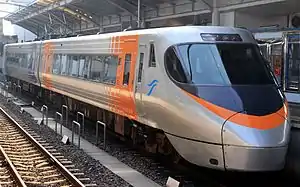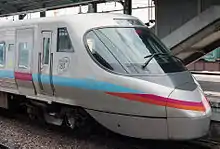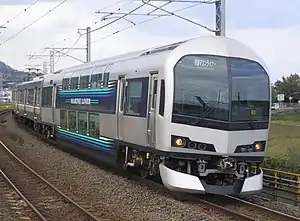JR Shikoku 8000 series
The 8000 series (8000系) is a tilting limited express electric multiple unit (EMU) train operated by Shikoku Railway Company (JR Shikoku) in Shikoku, Japan, since 1992.[1]
| 8000 series | |
|---|---|
 8000 series on a Shiokaze service in May 2007 | |
| Manufacturer | Hitachi, Nippon Sharyo |
| Constructed | 1992-1997 |
| Entered service | 1992 |
| Refurbished | 2004–2006 |
| Number built | 48 vehicles (12 sets) |
| Number in service | 45 vehicles (11 sets) |
| Fleet numbers | L1–6, S1–6 |
| Capacity | 281(5-car sets L1-L5) 277(5-car sets L6) 168(3-car sets) |
| Operator(s) | JR Shikoku |
| Depot(s) | Matsuyama |
| Specifications | |
| Car length | 22,600 mm (74 ft 2 in) |
| Width | 2,820 mm (9 ft 3 in) |
| Height | 3,360 mm (11 ft 0 in) |
| Floor height | 1,105 mm (3 ft 7.5 in) |
| Doors | Plug doors (2 per side) |
| Maximum speed | 130 km/h (80 mph) |
| Traction system | Variable frequency (GTO) |
| Current collection method | Overhead catenary |
| Safety system(s) | ATS-SS |
| Track gauge | 1,067 mm (3 ft 6 in) |
Operations
Formations
As of 1 October 2013, 48 vehicles were in service, formed as 3- and 5-car sets, as shown below.[2]
Prototype set S1
| Car No. | 6 | 7 | 8 |
|---|---|---|---|
| Designation | Mc | M | Tc1 |
| Numbering | 8201 | 8101 | 8501 |
Cars 6 and 8 are each fitted with one S-PS59 lozenge-type pantograph.[2] The pantograph on car 8 was removed in 2010.[3] This set were retired from service by March 2018.
Set S2-S6
| Car No. | 6 | 7 | 8 |
|---|---|---|---|
| Designation | Mc | T | Tc1 |
| Numbering | 8200 | 8300 | 8500 |
Cars 6 and 8 are each fitted with one S-PS59 lozenge-type pantograph.[2] The pantograph on car 8 was removed between 2010 and 2011.[3] Car 7 is removed from formations during off-peak seasons between 2011 and 2018.[3]
5-car sets L1–L6
| Car No. | 1 | 2 | 3 | 4 | 5 |
|---|---|---|---|---|---|
| Designation | Thsc | M1 | M2 | T | Tc2 |
| Numbering | 8000 | 8100 | 8150 | 8300 | 8400 |
- Half of car 8 includes Green car (first class) seating.[1] Cars 1 and 3 are each fitted with one S-PS59 lozenge-type pantograph.[2]
 Streamlined end of set 8001 in original livery, 1992
Streamlined end of set 8001 in original livery, 1992 Gangwayed end of set 8201 in original livery, 1992
Gangwayed end of set 8201 in original livery, 1992 A 5-car set in original livery, 1992
A 5-car set in original livery, 1992 Set S2 in revised livery, 2011
Set S2 in revised livery, 2011 Car 1 with pantograph removed, 2011
Car 1 with pantograph removed, 2011
History

The prototype set, S1, was delivered in May 1992,[1] and entered revenue service on 19 September 1992.[4]
On 8 August 1992, set 8001 achieved a speed of 160 km/h (99 mph) in a special test run.[2]
The subsequent fleet of full-production sets entered service from 18 March 1993.[5]
The entire fleet underwent life-extension refurbishment between 2004 and 2006.[4]
Livery variations
 An 8000 series EMU in Anpanman livery in March 2016
An 8000 series EMU in Anpanman livery in March 2016 An 8000 series set in May 2017 repainted in Taiwan Railways Administration EMU800-style livery
An 8000 series set in May 2017 repainted in Taiwan Railways Administration EMU800-style livery
References
- Jēāru zensharyō handobukku: Rail Magazine 2009 JR全車輌ハンドブック2009 [JR Rolling Stock Handbook 2009]. Japan: Neko Publishing. 2009. pp. 171–172. ISBN 978-4-7770-0836-0.
- JR電車編成表 2014冬 [JR EMU Formations - Winter 2014]. Japan: JRR. 1 December 2013. p. 204. ISBN 978-4-330-42413-2.
- Railway Journal (in Japanese) (525): 58. July 2010. Missing or empty
|title=(help) - Jr特急電車編成表: 1987~2012 JR特急電車編成表 1987~2012 [JR Limited Express EMU Formations - 1987-2012]. Japan: JRR. February 2012. pp. 61–62. ISBN 978-4-330-27012-8.
- Haraguchi, Takayuki (2009). Jr全車両: ビジュアル決定版 Encyclopedia of JR's Railway Cars: JR全車輌. Japan: Sekai Bunka. p. 40. ISBN 978-4-418-09905-4.
External links
| Wikimedia Commons has media related to JR Shikoku 8000. |
- JR Shikoku information (in Japanese)

